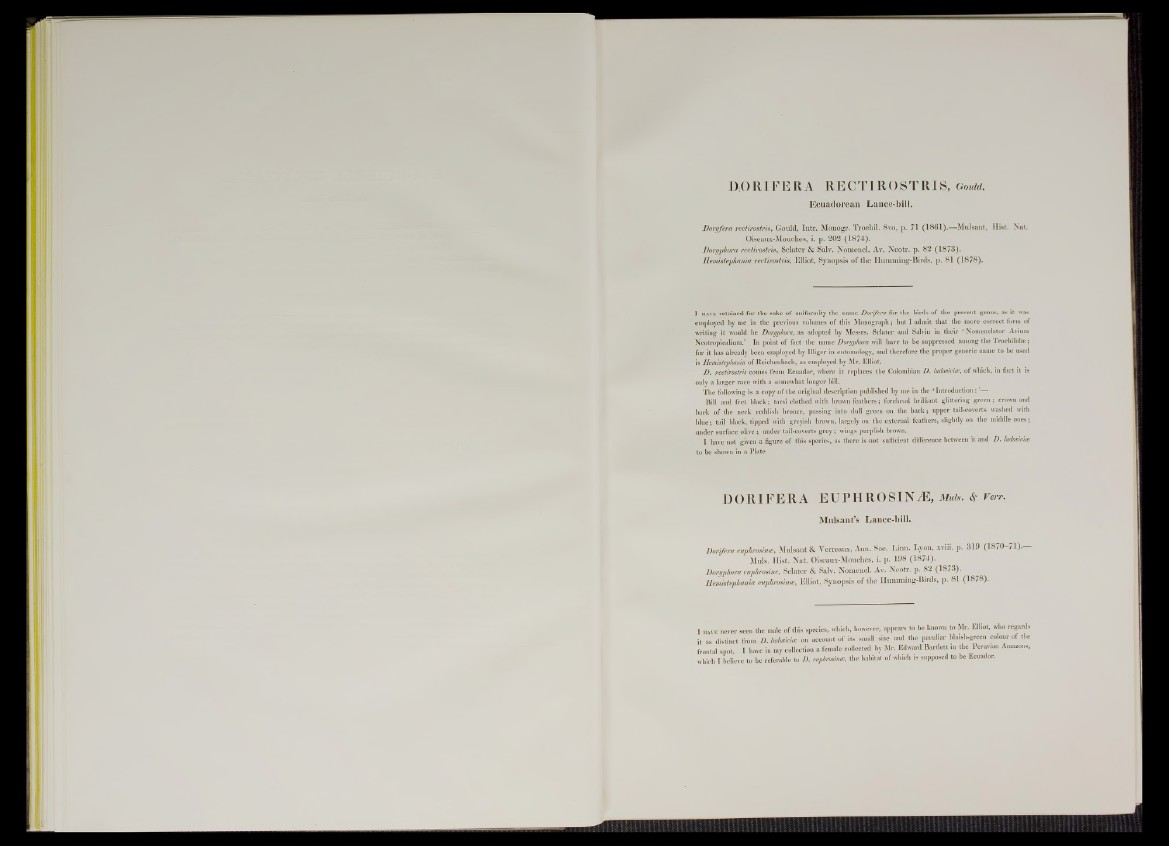
DiORIFERA RECTIROSTRIS, Gould.
Ecuadorean Lance-bill.
Donjfera rectirosù'is, Gould, Intr. Monogr. Trochil. 8 vo, p. 71 (1 8 6 1 ).— Mulsant, Hist. Nat.
Oiseaux-Mouches, i. p. 2 0 2 (1 8 7 4 ).
Doryphora rectirostns, Sclater & Salv. N om en d . Av. Neotr. p. 8 2 (1 8 7 3 ).
Hemistephania rectirostns, Elliot, Synopsis o f the Humming-Birds, p. 81 (1 8 7 8 ).
I h a v e retained for the sake of uniformity the name Dorifera for the birds of the present genus, as it was
employed by me iu the previous volumes of this Monograph; but I admit that the more correct form of
writing it would be Doryphora, as adopted by Messrs. Sclater and Salvin in their ‘ Nomenclátor Avium
Neotropicalium.’ In point of fact the name Doryphora will have to be suppressed among the Trochilidae;
for it has already been employed by Illiger in entomology, and therefore the proper generic name to be used
is Hemistephania o f Reichenbach, as employed by Mr. Elliot.
D. rectirostris comes from Ecuador, where it replaces the Colombian D . ludomcicc, of which, in fact it is
only a larger race with a somewhat longer bill.
The following is a copy of the original description published by me iu the ‘ Introduction : ’—
Bill and feet black; tarsi clothed with brown feathers; forehead brilliant glittering green ; crown and
back o f the neck reddish bronze, passing into dull green on the back; upper tail-coverts washed with
blue; tail black, tipped with greyish brown, largely on the external feathers, slightly on the middle ones;
under surface olive ; under tail-coverts grey; wings purplish brown.
I have not given a figure of this species, as there is not sufficient difference between it and D. ludoticiee
to be shown in a Plate
DORIFERA EUPHROSINÆ, Muis. # Verr.
Mnlsant’s Lance-bill.
Dorifera euphrosinoe, Mulsant & Verreaux, Ann. Soe. Linn. Lyon, xviii. p. 3 1 9 ( 1 8 7 0 -7 1 ) .
Muls. Hist. N a t. Oiseaux-Mouches, i. p. 1 9 8 (1 8 7 4 ).
Doryphora euphrosine, Sclater & Salv. Nomenol. Av. Neotr. p. 8 2 (1 8 7 3 ).
Hemistephania euphrosinoe, Elliot, Synopsis o f the Humming-Birds, p. 81 (1 8 7 8 ).
I h a v e never seen the male of this species, which, however, appears to be known to Mr. Elliot, who regards
it as distinct from D . ludomcuB on account of its small size and the peculiar bluish-green colour of the
frontal spot. I have in my collection a female collected by Mr. Edward Bartlett in the Penman Amazons,
which I believe to be referable to D. euphromte, the habitat o f which is supposed to be Ecuador.